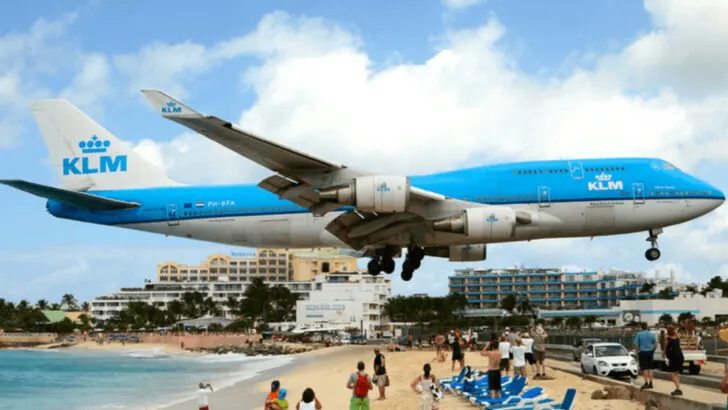When you think of a day at the beach, images of sunbathing, swimming, and relaxation come to mind. However, not all beaches offer such tranquility.
Some are notorious for lurking dangers, from powerful currents and treacherous wildlife to unpredictable weather and hazardous terrains. Exploring these beaches can be thrilling, but it’s essential to be aware of the risks involved.
This article delves into the 17 most perilous beaches worldwide, highlighting the unique hazards each one presents and why thrill-seekers and adventurers might be drawn to them, despite the threats.
Fraser Island, Australia
Fraser Island, a World Heritage site, is renowned for its pristine beauty. Yet, beneath its allure, lies a host of dangers. The island is infamous for its strong rip currents, which pose a significant threat to swimmers. Moreover, the surrounding waters teem with sharks, adding another layer of peril.
On land, visitors must contend with the island’s notorious dingoes. These wild dogs, although seemingly harmless, have been known to attack humans, particularly if they feel threatened or cornered. For the adventurous, Fraser Island offers a raw and untamed experience, but caution is paramount.
New Smyrna Beach, Florida
New Smyrna Beach holds the dubious title of “Shark Bite Capital of the World.” With its warm waters and abundant marine life, it’s a hotspot for surfers and sharks alike. The frequent shark encounters have made it a focal point for thrill-seeking surfers.
Despite the evident risks, the beach’s vibrant surf culture continues to draw enthusiasts. Caution is advised, especially during peak shark activity seasons.
The local community remains vigilant, providing ample warnings and safety measures to mitigate risks. Yet, the allure of riding the waves amidst such majestic creatures is irresistible for many.
Gansbaai, South Africa
Dubbed the “Great White Shark Capital of the World,” Gansbaai is synonymous with shark cage diving. The area attracts tourists eager to witness these majestic predators up close. However, the concentration of great whites makes the waters perilous for swimmers.
While the thrill of cage diving offers an adrenaline rush, it also underscores the dangers lurking beneath. The coastal town thrives on shark tourism, but respect for these powerful creatures is essential.
Adequate safety protocols are in place, though the unpredictable nature of the ocean demands caution at all times.
Praia de Boa Viagem, Brazil
Praia de Boa Viagem is a bustling urban beach, famous for its vibrant atmosphere. Yet, it’s notorious for shark attacks, particularly near the reefs. The construction of the nearby port disrupted local marine life, increasing shark activity.
Despite the risks, the beach remains a popular destination for both locals and tourists. Authorities have implemented several measures to warn visitors, including clear signage and lifeguard patrols.
For those undeterred by the presence of sharks, Praia de Boa Viagem offers a lively cultural experience, blending the thrill of the ocean with the pulsating energy of Recife.
Kilauea Beach, Hawaii
Located near one of the world’s most active volcanoes, Kilauea Beach offers a mesmerizing, albeit dangerous, landscape. The beach is prone to sudden volcanic activity, with lava flows occasionally reaching the ocean.
These flows create hazardous conditions, including toxic steam clouds and unstable terrains. While the sight of molten lava meeting the sea is awe-inspiring, visitors must exercise extreme caution.
The local authorities monitor volcanic activity closely, providing updates and warnings as needed. Kilauea Beach serves as a stark reminder of nature’s raw power and unpredictability.
Chowpatty Beach, India
Chowpatty Beach is iconic in Mumbai, known for its cultural significance and vibrant festivals. However, the beach’s waters are heavily polluted, posing health risks to visitors. Sewage discharge and industrial waste have degraded water quality significantly.
Despite pollution concerns, Chowpatty remains a hub for local festivities and gatherings. The juxtaposition of cultural vibrancy against environmental challenges is stark.
Efforts are underway to clean the beach and improve conditions, but the journey is ongoing. For those visiting, the beach offers a unique glimpse into Mumbai’s dynamic spirit, albeit with caution advised regarding water activities.
Playa Zipolite, Mexico
Known as the “Beach of the Dead,” Playa Zipolite is famed for its treacherous waters. The beach’s strong undercurrents and powerful waves have claimed numerous lives over the years. Despite the dangers, it remains popular among thrill-seekers.
For those willing to brave the risks, Zipolite offers a picturesque setting with golden sands and swaying palms. Lifeguards are present, but heed their warnings seriously.
The beach’s reputation for danger adds an element of allure for adventurous souls. Visitors are urged to respect the ocean’s power and prioritize safety at all times.
Skeleton Coast, Namibia
The Skeleton Coast, with its haunting name, paints a picture of desolation and danger. Known for its dense fog and rough seas, the coast is littered with shipwrecks. The arid desert meets the turbulent Atlantic, creating a stark yet captivating landscape.
Navigating these waters is perilous, with strong currents and unpredictable weather patterns.
Despite the risks, the coast’s eerie beauty attracts those with a taste for adventure. The remnants of shipwrecks tell tales of survival against nature’s odds, making it a destination steeped in history and intrigue.
Hanakapiai Beach, Hawaii
Hanakapiai Beach is a hidden gem along the Na Pali Coast, known for its breathtaking scenery. Yet, beneath its beauty lies danger. The beach is infamous for its strong rip currents and absence of a protective reef.
These currents have led to numerous drownings, earning it a reputation as one of Hawaii’s most hazardous beaches. The hike to the beach is challenging, adding to the sense of seclusion and adventure.
Visitors are captivated by the raw, untouched landscapes but must heed the numerous warning signs. Safety should always be the paramount concern here.
Reunion Island, France
Reunion Island, a tropical paradise, is known for its vibrant marine life. However, it’s gained notoriety for frequent shark attacks, leading to stringent safety measures. The island’s lush landscapes and turquoise waters contrast sharply with the underlying dangers.
Authorities have implemented shark nets and restricted swimming areas to protect visitors.
Despite these efforts, the allure of exploring Reunion Island’s beaches persists. The island offers a unique blend of natural beauty and cultural richness, but awareness and caution remain crucial when venturing into its waters.
Cape Tribulation, Australia
Cape Tribulation, where the rainforest meets the reef, offers stunning scenery. Yet, the area is fraught with danger, particularly from saltwater crocodiles. These stealthy predators inhabit the waterways and occasionally venture onto the beaches.
The remote location adds to the sense of adventure, attracting those eager to explore Australia’s wild side. Understanding and respecting the local wildlife is vital for safety.
Visitors are advised to heed warning signs and avoid swimming in certain areas. For those who dare, Cape Tribulation promises breathtaking landscapes and a glimpse into untamed nature.
Maho Beach, Saint Martin
Maho Beach, located near Princess Juliana International Airport, is famous for its close encounters with low-flying planes. This unique feature draws tourists eager to experience the thrill of planes roaring overhead.
While the spectacle is exhilarating, it presents inherent dangers. The forceful jet blasts can send sand and debris flying, posing risks to beachgoers. Caution is advised, and signs warn of potential hazards.
Despite the risks, the once-in-a-lifetime experience of witnessing aircraft up close keeps visitors flocking to this iconic beach.
Tamarama Beach, Australia
Tamarama Beach, affectionately known as “Glamarama,” is a popular spot near Sydney. Its stunning views and trendy vibe attract beachgoers year-round. However, the beach is notorious for its dangerous shore break and powerful surf.
The strong waves and rips make it a hazardous spot for swimming but a favorite among seasoned surfers. Lifeguards are always on duty, emphasizing the need for safety awareness.
For those seeking vibrant beach culture paired with thrilling surf, Tamarama is an enticing destination, though caution cannot be overstated.
Bikini Atoll, Marshall Islands
Bikini Atoll is steeped in history, being one of the nuclear test sites during the Cold War. The remnants of these tests have left a lasting impact, rendering the area unsafe for habitation.
Despite this, the atoll’s lagoons are a haven for divers, drawn by the eerie beauty of sunken ships and vibrant marine life. The juxtaposition of devastation against natural rebirth is striking.
Visitors are reminded of the atoll’s history while marveling at its underwater treasures. Diving here is both a sobering and awe-inspiring experience, tempered by the ghosts of its past.
Ziplining over Waimea Bay, Hawaii
Waimea Bay is renowned for its massive waves, attracting surfers from around the globe. During the winter season, the surf can reach towering heights, offering a spectacle of nature’s power.
For those seeking adventure, ziplining over Waimea provides a unique vantage point. The thrill of soaring above the crashing waves is unparalleled, though it demands courage and respect for the forces below.
Safety measures are robust, ensuring a secure yet exhilarating experience. Waimea Bay encapsulates the raw energy of Hawaii’s surf culture, captivating all who visit.
Cabo Polonio, Uruguay
Cabo Polonio is a remote and picturesque beach, accessible only by 4×4 vehicles or on foot. Its isolation adds to its allure, attracting those looking to escape the hustle and bustle of modern life.
However, the strong currents and unpredictable weather can pose serious risks. The lack of infrastructure, including lifeguard presence, means visitors must be self-reliant and informed about the dangers.
Despite these challenges, Cabo Polonio offers a unique opportunity to connect with nature in its purest form, making it a cherished destination for intrepid travelers.
Shark Bay, Western Australia
Shark Bay, located in Western Australia, is a wonder of natural beauty. However, lurking beneath its azure waters are numerous species of aggressive sharks. This bay is home to tiger sharks and other predatory species, making swimming a significant risk.
Visitors should be aware of the potential for encounters with these apex predators. Local authorities often advise against swimming and encourage observing from a safe distance. Shark Bay’s allure lies in its raw, untamed nature.
Did you know? Shark Bay was named for its large population of these formidable creatures, drawing scientists and thrill-seekers alike.

